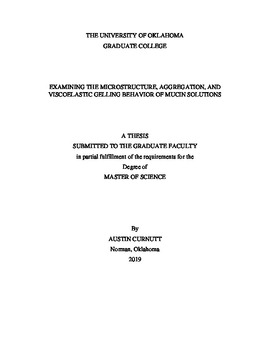| dc.description.abstract | Mucin solutions offer a simplified, yet still very complex, opportunity to study the microstructural and mechanical properties of mucosal fluids. The complex viscoelastic behavior of mucus is a result of electrostatic and hydrophobic interactions of large, polymeric mucin glycoproteins with other mucin molecules and their environment. Understanding mucin behavior and how to manipulate it is a crucial research field, presenting opportunities for advancement in drug delivery through mucosal membranes as well as mucus-related conditions like chronic obstructive pulmonary disease (COPD) and cystic fibrosis.
Work presented here is aimed at developing a stronger understanding of mucin microstructural and viscoelastic properties and the effects of pH, calcium chloride, small molecule compounds, and negatively-charged silica nanoparticles (SiNPs). Specifically, findings are presented regarding (1) the sol-gel transition behavior and the effect of pH and Ca2+, (2) the effects of choline chloride, phenylboronic acid, and triethanolamine on mucin aggregation and rheology, and (3) synthesis of SiNPs and their effects on mucin aggregation and rheology. The data and findings presented were characterized using frequency-dependent rheology, dynamic light scattering (DLS) particle measurements, zeta potential (ZP), Fourier-transform infrared spectroscopy (FTIR), and Du Noüy ring surface tensiometry.
Mucus was simulated using solutions of porcine gastric mucin (PGM) in water and concentration was held constant throughout the entire study. pH modification and CaCl2 addition were used to modify the gelling behavior of mucin, which was characterized in situ using all the methods described above. Small molecule compounds were obtained and added to mucin solutions to induce changes in mucin-mucin interactions, measured using DLS, ZP, and rheology. SiNPs were synthesized, characterized, and added to mucin solutions and their effects were also measured using DLS, ZP, and rheology.
The results demonstrate the known phenomenon of PGM aggregation and gelling at pH ≤4, as well as an increase in viscoelastic properties at pH 4.0 and 5.8 with the addition of CaCl2 at 10 mM. FTIR was used in a new way to demonstrate increased glycosylation in mucin solutions at pH values of 2-5, suggesting a mechanism for aggregation seen through other methods. Rheological results for the small molecule compounds were mixed, but DLS and ZP confirmed a reduction in aggregation of ~70% at higher concentrations of each compound. The effects of ion content and changes in pH may have played a role, but do not interfere with or contradict the general finding. The Stöber process was successfully used to synthesis fairly uniform SiNPs, which produced consistent trends in PGM behavior. As negatively-charge particles with -OH functionality, they behaved similar to phenylboronic acid, inducing a decrease in viscoelastic properties at all concentrations and a decrease in ZP and particle size with increasing NP concentration | en_US |
